Spatial Vulnerability Assessment for Mountain Cities Based on the GA-BP Neural Network: A Case Study in Linzhou, Henan, China
Abstract
:1. Introduction
2. Materials and Methods
2.1. Spatial Vulnerability Assessment Framework
2.2. Study Area
2.3. Index System and the Data Sources
2.3.1. Index System
- Exposure index
- 2.
- Sensitivity index
- 3.
- Adaptive capacity index
2.3.2. Data Sources
2.4. Research Method
2.4.1. PCA Preassessment
2.4.2. GA-BP Neural Network Assessment Model
- 1.
- Principle of the BP neural network (BP)
- 2.
- Principle of the genetic algorithm (GA)
- 3.
- Network construction
- 4.
- Optimization process
- 5.
- Training process
2.4.3. GWR Analysis
3. Results
3.1. Accuracy Verification
3.2. Vulnerability Assessment Results
3.2.1. Vulnerability of the Ecological Protection System
3.2.2. Vulnerability of the Agricultural Production System
3.2.3. Vulnerability of the Urban Construction System
3.2.4. Vulnerability of the Coupling System
3.3. GWR Analysis Results
4. Discussion
4.1. Applicability of the Assessment Framework
4.2. Reliability of Results
4.3. Sustainable Development Suggestions
4.4. Limitations
5. Conclusions
Author Contributions
Funding
Data Availability Statement
Acknowledgments
Conflicts of Interest
Appendix A
| Index | Indicator | Rationale |
|---|---|---|
| X1 | Population density | With the increase in population, human activities such as overexploitation of natural resources, environmental pollution, and vegetation destruction will lead to the intensification of ecological vulnerability. |
| X2 | Proportion of woodland area | The main land types in Linzhou are woodland, grassland, and cultivated land, and phenomena such as deforestation and grass destruction can lead to increased ecological vulnerability. |
| X3 | Proportion of grassland area | |
| X4 | Comprehensive index of land-use degree | Land-use degree is a measure which can reflect the extent of human impact on nature, containing information on patterns and their proportions of land use. Overexploitation of land leads to a decline in the total amount of natural resources and the quality of the ecological environment, and increases ecological vulnerability. |
| X5 | Aridity index | Arid environments can limit vegetation growth, and reduce grassland productivity, negatively impacting ecosystems and increasing ecological vulnerability |
| X6 | Soil erosion intensity | The type of soil erosion in Linzhou is mainly hydraulic erosion, which mainly responds to the state of soil susceptibility to erosion, and soil erodibility increases ecological vulnerability. |
| X7 | Normalized difference vegetation index | The normalized difference vegetation index is used to assess the degree of vegetation coverage. Areas with high vegetation cover play an important role in maintaining slope stability and are less susceptible to environmental changes, reducing ecological vulnerability. |
| X8 | Soil conservation | Soil conservation reduces ecological vulnerability through capacity to conserve soil and control erosion. |
| X9 | Biodiversity | Biodiversity reduces ecological vulnerability by increasing ecosystem resilience to disturbance. |
| X10 | Water conservation | Water conservation is mainly manifested in ecosystems that intercept precipitation, regulate runoff, purify water, etc., which helps to reduce ecological vulnerability. |
| X11 | Climate regulation value | Climate regulation capacity reduces ecological vulnerability by mitigating the effects of climate change. |
| X12 | Intensity of extreme rainfall | High intensity of rainfall may lead to waterlogging situation, and it may sometimes adversely affect crop productivity, resulting in increased agricultural vulnerability. |
| X13 | Proportion of cultivated land | The main land types in Linzhou are woodland, grassland, and cultivated land. Encroachment on cultivated land results in reduced soil fertility, which increases the agricultural vulnerability. |
| X14 | Annual average precipitation | Insufficient or uneven precipitation inhibits crop growth and increases agricultural vulnerability. |
| X15 | Annual average temperature | Lower temperature inhibits crop growth and increases agricultural vulnerability. |
| X16 | Slope | The proportion of sloping cultivated land of 6–25° in Linzhou is as high as 43.79%, and sloping cultivated land can easily lead to soil fertility loss and increase agricultural vulnerability. |
| X17 | Distance from a water source | Distance from a water source affects agricultural water management, and increased distance to water increases agricultural vulnerability. |
| X18 | Farmland productivity potential | Farmland productivity potential is an index to measure soil crop production capacity by integrating agricultural technology, topography, climate, and other factors in Linzhou. High farmland production potential helps to reduce agricultural vulnerability. |
| X19 | Number of agricultural workforce | The increase in agricultural workforce will contribute to the exchange of agricultural resources and technical skills and reduce agricultural vulnerability. |
| X20 | Total power of agricultural machinery | The input of agricultural mechanization helps to improve the efficiency ofagricultural activities such as sowing and threshing, and reduce agricultural vulnerability. |
| X21 | Hidden danger of geological collapse | Linzhou is a high risk area for geologic hazards. Disasters such as collapses, landslides, and mudflows threaten social and urban infrastructure and increase urban vulnerability. |
| X22 | Hidden danger of landslides | |
| X23 | Hidden danger of mudflows | |
| X24 | Nighttime Light intensity | The distribution of nighttime lights reflects the scale of the regional economy and human activities. The higher the intensity of nighttime light, the greater the intensity of human activity, which leads to the increase in urban vulnerability. |
| X25 | Proportion of construction land | The construction land in Linzhou is expanding continuously. High-intensity land construction leads to the increase in urban vulnerability. |
| X26 | Elevation | Elevation is an important factor influencing climate change and geological stability. Areas of higher elevation are less susceptible to building of urban infrastructure and increase in urban vulnerability. |
| X27 | Topographic undulation | In areas with large undulating topography, the stability of infrastructure construction is poor, and it is more vulnerable to external environment, which leads to the increase in urban vulnerability. |
| X28 | Rate of natural population increase | Rate of natural population increase characterizes the stability of population change. Positive population growth indicates that the urban has a good and stable living environment and that the urban vulnerability is low. |
| X29 | Road density | Developed transportation systems improve the response ability in the early stage of disaster and reduce urban vulnerability. |
| X30 | Density of educational facilities | Popularizing disaster-related education and improving capacity to respond to emergencies contribute to reducing urban vulnerability. |
| X31 | Density of medical institutions | Rational arrangement of medical facilities can improve urban rescue capacity and reduce urban vulnerability. |
| X32 | Density of urban green spaces and parks | In the face of emergencies, urban parks and green spaces help reduce urban vulnerability by providing emergency shelter. |
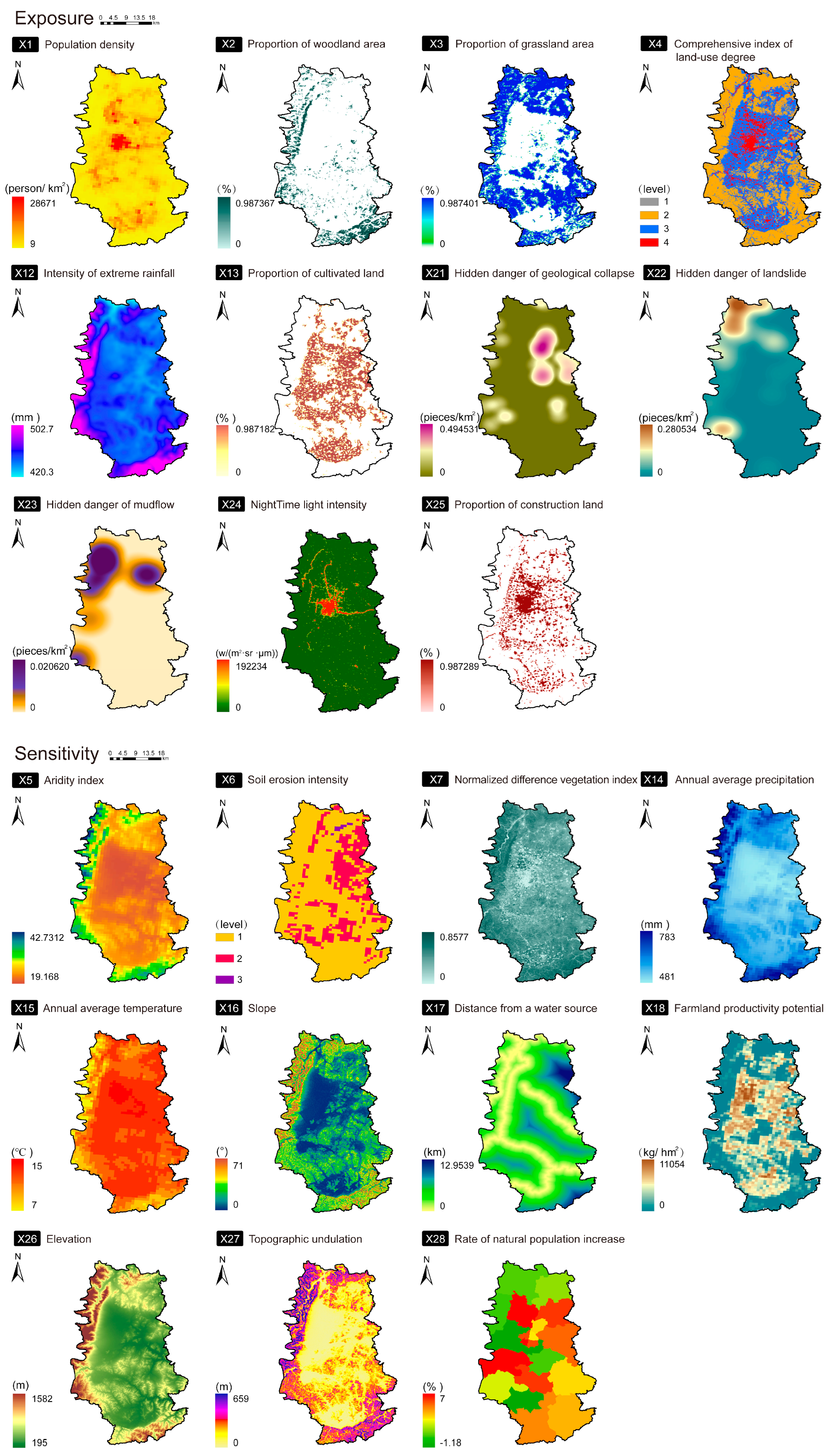
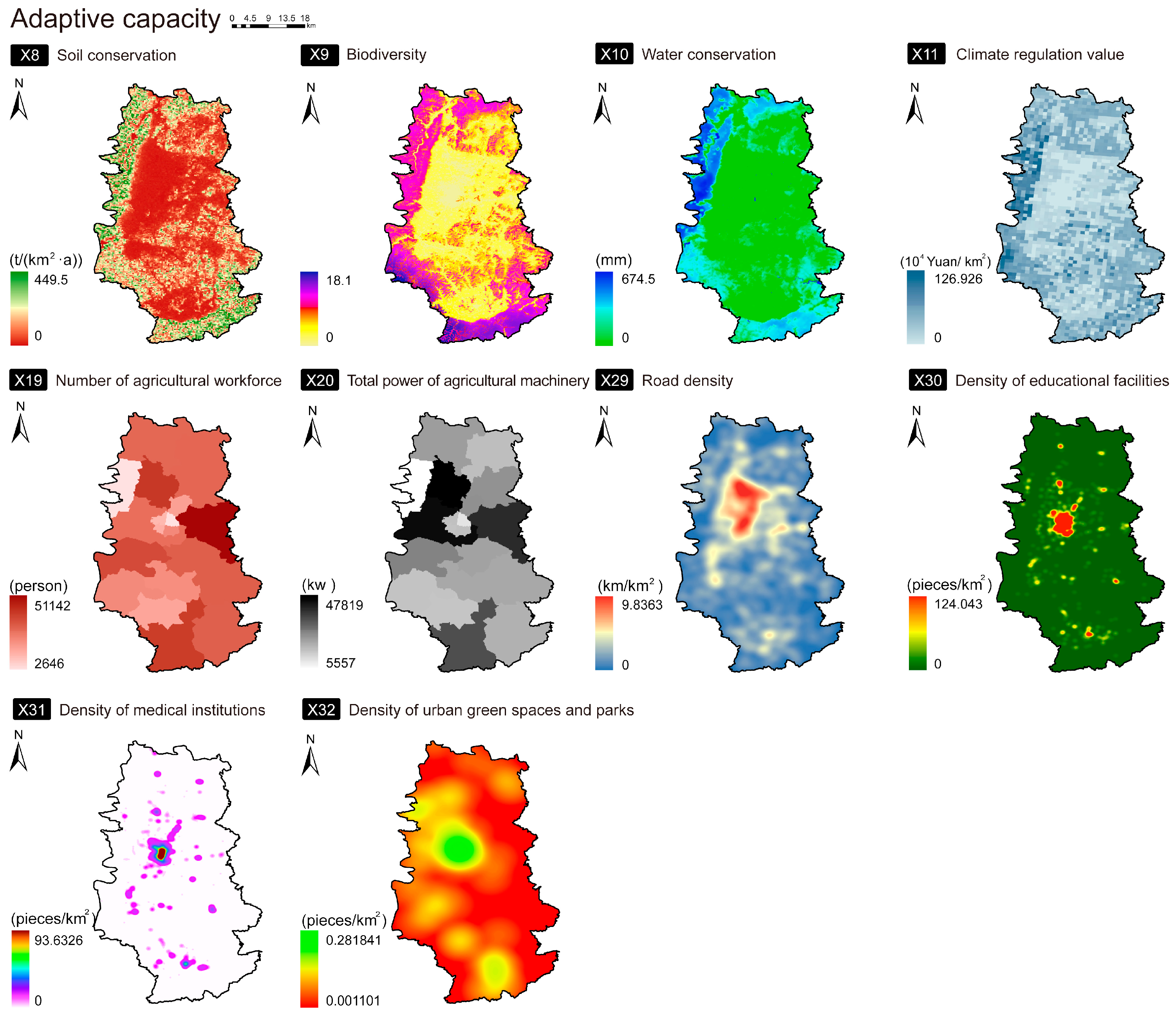
| System | Principal Component | Eigenvalue | Contribution Rate (%) | Cumulative Contribution Rate (%) | KMO |
|---|---|---|---|---|---|
| Ecological protection system | 1 | 5.261 | 47.831 | 47.831 | 0.876 |
| 2 | 1.329 | 12.084 | 59.915 | ||
| 3 | 0.97 | 8.816 | 68.731 | ||
| 4 | 0.854 | 7.767 | 76.498 | ||
| Agricultural production system | 1 | 4.425 | 49.166 | 49.166 | 0.808 |
| 2 | 1.353 | 15.036 | 64.203 | ||
| 3 | 1.037 | 11.518 | 75.72 | ||
| 4 | 0.832 | 9.25 | 84.97 | ||
| Urban construction system | 1 | 3.903 | 32.527 | 32.527 | 0.739 |
| 2 | 2.245 | 18.707 | 51.234 | ||
| 3 | 1.403 | 11.688 | 62.922 | ||
| 4 | 1.03 | 8.585 | 71.507 | ||
| Coupling system | 1 | 11.728 | 36.649 | 36.649 | 0.844 |
| 2 | 3.789 | 11.841 | 48.49 | ||
| 3 | 1.912 | 5.975 | 54.465 | ||
| 4 | 1.753 | 5.479 | 59.944 | ||
| 5 | 1.447 | 4.523 | 64.467 | ||
| 6 | 1.303 | 4.072 | 68.539 | ||
| 7 | 1.207 | 3.771 | 72.309 | ||
| 8 | 1.02 | 3.188 | 75.497 | ||
| 9 | 0.879 | 2.746 | 78.243 |
References
- Terzi, S.; Torresan, S.; Schneiderbauer, S.; Critto, A.; Zebisch, M.; Marcomini, A. Multi-Risk Assessment in Mountain Regions: A Review of Modelling Approaches for Climate Change Adaptation. J. Environ. Manag. 2019, 232, 759–771. [Google Scholar] [CrossRef] [PubMed]
- Chakraborty, A. Mountains as Vulnerable Places: A Global Synthesis of Changing Mountain Systems in the Anthropocene. GeoJournal 2021, 86, 585–604. [Google Scholar] [CrossRef]
- Schipper, L.; Pelling, M. Disaster Risk, Climate Change and International Development: Scope for, and Challenges to, Integration. Disasters 2006, 30, 19–38. [Google Scholar] [CrossRef] [PubMed]
- Hinkel, J. “Indicators of Vulnerability and Adaptive Capacity”: Towards a Clarification of the Science–Policy Interface. Glob. Environ. Chang. 2011, 21, 198–208. [Google Scholar] [CrossRef]
- Raikes, J.; Smith, T.F.; Baldwin, C.; Henstra, D. The Influence of International Agreements on Disaster Risk Reduction. Int. J. Disaster Risk Reduct. 2022, 76, 102999. [Google Scholar] [CrossRef]
- Wang, X.; Palazzo, D.; Carper, M. Ecological Wisdom as an Emerging Field of Scholarly Inquiry in Urban Planning and Design. Landsc. Urban Plan. 2016, 155, 100–107. [Google Scholar] [CrossRef]
- Patten, D.T. The Role of Ecological Wisdom in Managing for Sustainable Interdependent Urban and Natural Ecosystems. Landsc. Urban Plan. 2016, 155, 3–10. [Google Scholar] [CrossRef]
- Steiner, F. The Ecological Wisdom of Plan-Making. J. Urban Manag. 2018, 7, 124–130. [Google Scholar] [CrossRef]
- Wang, X.; Xiang, W.-N. Ecological Wisdom for Urban Sustainability: Doing Real and Permanent Good in Ecological Practice. Landsc. Urban Plan. 2016, 155, 1–2. [Google Scholar] [CrossRef]
- Douglas, E.M.; Reardon, K.M.; Täger, M.C. Participatory Action Research as a Means of Achieving Ecological Wisdom within Climate Change Resiliency Planning. J. Urban Manag. 2018, 7, 152–160. [Google Scholar] [CrossRef]
- Simandan, D. The Wise Stance in Human Geography. Trans. Inst. Br. Geogr. 2011, 36, 188–192. [Google Scholar] [CrossRef]
- Birkmann, J.; Jamshed, A.; McMillan, J.M.; Feldmeyer, D.; Totin, E.; Solecki, W.; Ibrahim, Z.Z.; Roberts, D.; Kerr, R.B.; Poertner, H.-O.; et al. Exposure, Sensitivity and Adaptive Capacity. Sci. Total Environ. 2022, 803, 150065. [Google Scholar] [CrossRef] [PubMed]
- Turner, B.L.; Zhou, B.-B. Reflections on a Vulnerability Framework for Sustainability Science. Jamba J. Disaster Risk Stud. 2023, 15, 1335. [Google Scholar] [CrossRef]
- Zou, T.; Chang, Y.; Chen, P.; Liu, J. Spatial-Temporal Variations of Ecological Vulnerability in Jilin Province (China), 2000 to 2018. Ecol. Indic. 2021, 133, 108429. [Google Scholar] [CrossRef]
- Swami, D.; Parthasarathy, D. Dynamics of Exposure, Sensitivity, Adaptive Capacity and Agricultural Vulnerability at District Scale for Maharashtra, India. Ecol. Indic. 2021, 121, 107206. [Google Scholar] [CrossRef]
- Han, X.; Wang, P.; Wang, J.; Qiao, M.; Zhao, X. Evaluation of Human-Environment System Vulnerability for Sustainable Development in the Liupan Mountainous Region of Ningxia, China. Environ. Dev. 2020, 34, 100525. [Google Scholar] [CrossRef]
- Iglesias-Pascual, R.; Benassi, F.; Hurtado-Rodríguez, C. Social Infrastructures and Socio-Economic Vulnerability: A Socio-Territorial Integration Study in Spanish Urban Contexts. Cities 2023, 132, 104109. [Google Scholar] [CrossRef]
- Xia, C.; Zhai, G. Territorial Spatial Vulnerability Assessment Based on PSO-BP Neural Network: A Case Study in Shenzhen, China. Ecol. Inform. 2023, 75, 102088. [Google Scholar] [CrossRef]
- Wang, X. Ecological Wisdom as a Guide for Implementing the Precautionary Principle. Socio Ecol. Pract. Res. 2019, 1, 25–32. [Google Scholar] [CrossRef]
- Darabi, H.; Farsani, I.; Behbahani, I. Evaluation of Ecological Vulnerability in Chelgard Mountainous. Landscape 2019, 4, 597–610. [Google Scholar]
- Villegas-González, P.A.; Ramos-Cañón, A.M.; González-Méndez, M.; González-Salazar, R.E.; De Plaza-Solórzano, J.S. Territorial Vulnerability Assessment Frame in Colombia: Disaster Risk Management. Int. J. Disaster Risk Reduct. 2017, 21, 384–395. [Google Scholar] [CrossRef]
- Nan, G.; Han, L.; Wang, Y. Assessing Vulnerability of Coupled Human–Environment Systems and Its Influence Factors in Yan’an City, China. Hum. Ecol. Risk Assess. Int. J. 2022, 28, 783–801. [Google Scholar] [CrossRef]
- Molden, D.; Hurni, H.; von Dach, S.W.; Zimmermann, A.B. Focus Issue: Vulnerability and Resilience to Natural Hazards and Disasters in Mountains. Mt. Res. Dev. 2015, 35, 103. [Google Scholar] [CrossRef]
- Wilson, G.A.; Schermer, M.; Stotten, R. The Resilience and Vulnerability of Remote Mountain Communities: The Case of Vent, Austrian Alps. Land Use Policy 2018, 71, 372–383. [Google Scholar] [CrossRef]
- Yang, X.; Yu, Y.; Zheng, Y. Assessment and Optimization of Territorial Space Vulnerability: A Case Study of Xingyang, Henan, China. Phys. Chem. Earth Parts A/B/C 2020, 120, 102950. [Google Scholar] [CrossRef]
- Hu, X.; Ma, C.; Huang, P.; Guo, X. Ecological Vulnerability Assessment Based on AHP-PSR Method and Analysis of Its Single Parameter Sensitivity and Spatial Autocorrelation for Ecological Protection—A Case of Weifang City, China. Ecol. Indic. 2021, 125, 107464. [Google Scholar] [CrossRef]
- Liu, B.; Han, R.; Tang, L.; Cheng, X. An Object–Pressure–Endurance–Resilience System for Assessing the Vulnerability of Coastal Zone Ecosystems. Ecol. Indic. 2022, 141, 109105. [Google Scholar] [CrossRef]
- Xiao, Y.; Tang, X.; Li, Y.; Huang, H.; An, B.-W. Social Vulnerability Assessment of Landslide Disaster Based on Improved TOPSIS Method: Case Study of Eleven Small Towns in China. Ecol. Indic. 2022, 143, 109316. [Google Scholar] [CrossRef]
- Xiong, J.; Sun, M.; Zhang, H.; Cheng, W.; Yang, Y.; Sun, M.; Cao, Y.; Wang, J. Application of the Levenburg–Marquardt Back Propagation Neural Network Approach for Landslide Risk Assessments. Nat. Hazards Earth Syst. Sci. 2019, 19, 629–653. [Google Scholar] [CrossRef]
- Zhao, G.; Zhang, Y.; Shi, Y.; Lan, H.; Yang, Q. The Application of BP Neural Networks to Analysis the National Vulnerability. Comput. Mater. Contin. 2019, 58, 421–436. [Google Scholar] [CrossRef]
- Xu, C.; Gong, A.; Liang, L.; Song, X.; Wang, Y. Vulnerability Assessment Method for Immovable Cultural Relics Based on Artificial Neural Networks—An Example of a Heavy Rainfall Event in Henan Province. Int. J. Disaster Risk Sci. 2023, 14, 41–51. [Google Scholar] [CrossRef]
- Wang, S.; Zhang, N.; Wu, L.; Wang, Y. Wind Speed Forecasting Based on the Hybrid Ensemble Empirical Mode Decomposition and GA-BP Neural Network Method. Renew. Energy 2016, 94, 629–636. [Google Scholar] [CrossRef]
- Qian, L.; Zhao, J.; Ma, Y. Option Pricing Based on GA-BP Neural Network. Procedia Comput. Sci. 2022, 199, 1340–1354. [Google Scholar] [CrossRef]
- Bai, G.; Xu, T. Coal Mine Safety Evaluation Based on Machine Learning: A BP Neural Network Model. Comput. Intell. Neurosci. 2022, 2022, e5233845. [Google Scholar] [CrossRef] [PubMed]
- Liu, L. Assessment of Water Resource Security in Karst Area of Guizhou Province, China. Sci. Rep. 2021, 11, 7641. [Google Scholar] [CrossRef] [PubMed]
- The “14th Five-Year Plan” for Territorial Spatial Ecological Restoration in Linzhou. Available online: http://www.linzhou.gov.cn/sitesources/lzsrmzf/page_pc/zwgk/zc/xzgfxwj/lz/articleaae81efd7efd%204b1e982ca23f44139490.html (accessed on 25 April 2024).
- Adger, W.N. Vulnerability. Glob. Environ. Chang. 2006, 16, 268–281. [Google Scholar] [CrossRef]
- Liu, X.; Wang, Y.; Peng, J.; Braimoh, A.K.; Yin, H. Assessing Vulnerability to Drought Based on Exposure, Sensitivity and Adaptive Capacity: A Case Study in Middle Inner Mongolia of China. Chin. Geogr. Sci. 2013, 23, 13–25. [Google Scholar] [CrossRef]
- Füssel, H.-M. Vulnerability: A Generally Applicable Conceptual Framework for Climate Change Research. Glob. Environ. Chang. 2007, 17, 155–167. [Google Scholar] [CrossRef]
- Afsari, R.; Nadizadeh Shorabeh, S.; Bakhshi Lomer, A.R.; Homaee, M.; Arsanjani, J.J. Using Artificial Neural Networks to Assess Earthquake Vulnerability in Urban Blocks of Tehran. Remote Sens. 2023, 15, 1248. [Google Scholar] [CrossRef]
- Uddin, M.N.; Saiful Islam, A.K.M.; Bala, S.K.; Islam, G.M.T.; Adhikary, S.; Saha, D.; Haque, S.; Fahad, M.G.R.; Akter, R. Mapping of Climate Vulnerability of the Coastal Region of Bangladesh Using Principal Component Analysis. Appl. Geogr. 2019, 102, 47–57. [Google Scholar] [CrossRef]
- Xiao, H.; Shao, H.; Long, J.; Zhang, S.; He, S.; Wang, D. Spatial-Temporal Pattern Evolution and Geological Influence Factors Analysis of Ecological Vulnerability in Western Sichuan Mountain Region. Ecol. Indic. 2023, 155, 110980. [Google Scholar] [CrossRef]
- Li, X.; Wang, Y.; Song, Y. Unraveling Land System Vulnerability to Rapid Urbanization: An Indicator-Based Vulnerability Assessment for Wuhan, China. Environ. Res. 2022, 211, 112981. [Google Scholar] [CrossRef] [PubMed]
- Gong, J.; Jin, T.; Cao, E.; Wang, S.; Yan, L. Is Ecological Vulnerability Assessment Based on the VSD Model and AHP-Entropy Method Useful for Loessial Forest Landscape Protection and Adaptative Management? A Case Study of Ziwuling Mountain Region, China. Ecol. Indic. 2022, 143, 109379. [Google Scholar] [CrossRef]
- Liu, Y.; Shu, B.; Chen, Y.; Zhang, H. Spatial Vulnerability Assessment of Rural Settlements in Hilly Areas Using BP Neural Network Algorithm. Ecol. Indic. 2023, 157, 111278. [Google Scholar] [CrossRef]
- Peng, J.; Zhang, J. Urban Flooding Risk Assessment Based on GIS-Game Theory Combination Weight: A Case Study of Zhengzhou City. Int. J. Disaster Risk Reduct. 2022, 77, 103080. [Google Scholar] [CrossRef]
- Pearce, T.; Smit, B.; Duerden, F.; Ford, J.D.; Goose, A.; Kataoyak, F. Inuit vulnerability and adaptive capacity to climate change in Ulukhaktok, Northwest Territories, Canada. Polar Rec. 2010, 46, 157–177. [Google Scholar] [CrossRef]
- Shao, H.; Liu, M.; Shao, Q.; Sun, X.; Wu, J.; Xiang, Z.; Yang, W. Research on Eco-Environmental Vulnerability Evaluation of the Anning River Basin in the Upper Reaches of the Yangtze River. Environ. Earth Sci. 2014, 72, 1555–1568. [Google Scholar] [CrossRef]
- Ma, Y.; Guga, S.; Xu, J.; Su, Y.; Liu, X.; Tong, Z.; Zhang, J. Agricultural Vulnerability Assessment of High-Temperature Disaster in Shaanxi Province of China. Agriculture 2022, 12, 980. [Google Scholar] [CrossRef]
- Hoque, M.Z.; Cui, S.; Xu, L.; Islam, I.; Tang, J.; Ding, S. Assessing Agricultural Livelihood Vulnerability to Climate Change in Coastal Bangladesh. Int. J. Environ. Res. Public Health 2019, 16, 4552. [Google Scholar] [CrossRef]
- Jiao, L.; Wang, L.; Lu, H.; Fan, Y.; Zhang, Y.; Wu, Y. An Assessment Model for Urban Resilience Based on the Pressure-State-Response Framework and BP-GA Neural Network. Urban Clim. 2023, 49, 101543. [Google Scholar] [CrossRef]
- Lindner, M.; Maroschek, M.; Netherer, S.; Kremer, A.; Barbati, A.; Garcia-Gonzalo, J.; Seidl, R.; Delzon, S.; Corona, P.; Kolström, M.; et al. Climate Change Impacts, Adaptive Capacity, and Vulnerability of European Forest Ecosystems. For. Ecol. Manag. 2010, 259, 698–709. [Google Scholar] [CrossRef]
- Luo, Q.; Bao, Y.; Wang, Z.; Chen, X.; Wei, W.; Fang, Z. Vulnerability Assessment of Urban Remnant Mountain Ecosystems Based on Ecological Sensitivity and Ecosystem Services. Ecol. Indic. 2023, 151, 110314. [Google Scholar] [CrossRef]
- Liu, Y.; Lü, Y.; Zhao, M.; Fu, B. Integrative Analysis of Biodiversity, Ecosystem Services, and Ecological Vulnerability Can Facilitate Improved Spatial Representation of Nature Reserves. Sci. Total Environ. 2023, 879, 163096. [Google Scholar] [CrossRef]
- Fistola, R.; Gargiulo, C.; La Rocca, R.A. Rethinking Vulnerability in City-Systems: A Methodological Proposal to Assess “Urban Entropy”. Environ. Impact Assess. Rev. 2020, 85, 106464. [Google Scholar] [CrossRef]
- Zhuang, D.; Liu, J. Modeling of Regional Differentiation of Land-Use Degree in China. Chin. Geogr. Sci. 1997, 7, 302–309. [Google Scholar] [CrossRef]
- Nygren, B.L.; O’Reilly, C.E.; Rajasingham, A.; Omore, R.; Ombok, M.; Awuor, A.O.; Jaron, P.; Moke, F.; Vulule, J.; Laserson, K.; et al. The Relationship between Distance to Water Source and Moderate-to-Severe Diarrhea in the Global Enterics Multi-Center Study in Kenya, 2008–2011. Am. J. Trop. Med. Hyg. 2016, 94, 1143–1149. [Google Scholar] [CrossRef]
- Xin, Z.; Xiaoyu, Z.; Hao, L.; Chenyi, Z.; Zhile, S.; Lijun, J.; Zelin, W.; Zheng, F.; Jiayang, Y.; Xin, Y.; et al. The Relationship between Geological Disasters with Land Use Change, Meteorological and Hydrological Factors: A Case Study of Neijiang City in Sichuan Province. Ecol. Indic. 2023, 154, 110840. [Google Scholar] [CrossRef]
- Li, J.; Cheng, J.; Shi, J.; Huang, F. Brief Introduction of Back Propagation (BP) Neural Network Algorithm and Its Improvement. In Advances in Computer Science and Information Engineering; Jin, D., Lin, S., Eds.; Advances in Intelligent and Soft Computing; Springer: Berlin/Heidelberg, Germany, 2012; Volume 169, pp. 553–558. ISBN 978-3-642-30222-0. [Google Scholar]
- Wu, Z.-J.; Tian, S.; Ma, L. A 4D Trajectory Prediction Model Based on the BP Neural Network. J. Intell. Syst. 2020, 29, 1545–1557. [Google Scholar] [CrossRef]
- Tian, Y.; Bai, L.; Wei, L.; Zheng, K.; Zhou, X. Modeling for Project Portfolio Benefit Prediction via a GA-BP Neural Network. Technol. Forecast. Soc. Chang. 2022, 183, 121939. [Google Scholar] [CrossRef]
- Wang, S.; Fang, C.; Ma, H.; Wang, Y.; Qin, J. Spatial Differences and Multi-Mechanism of Carbon Footprint Based on GWR Model in Provincial China. J. Geogr. Sci. 2014, 24, 612–630. [Google Scholar] [CrossRef]
- Zheng, D.; Qian, Z.; Liu, Y.; Liu, C. Prediction and Sensitivity Analysis of Long-Term Skid Resistance of Epoxy Asphalt Mixture Based on GA-BP Neural Network. Constr. Build. Mater. 2018, 158, 614–623. [Google Scholar] [CrossRef]
- Zou, Q.; Cui, P.; Zhou, G.G.; Li, S.; Tang, J.; Li, S. A New Approach to Assessing Vulnerability of Mountain Highways Subject to Debris Flows in China. Prog. Phys. Geogr. Earth Environ. 2018, 42, 305–329. [Google Scholar] [CrossRef]
- Letsie, M.M.; Grab, S.W. Assessment of Social Vulnerability to Natural Hazards in the Mountain Kingdom of Lesotho. Mt. Res. Dev. 2015, 35, 115–125. [Google Scholar] [CrossRef]
- Pham, Q.B.; Ali, S.A.; Bielecka, E.; Calka, B.; Orych, A.; Parvin, F.; Łupikasza, E. Flood Vulnerability and Buildings’ Flood Exposure Assessment in a Densely Urbanised City: Comparative Analysis of Three Scenarios Using a Neural Network Approach. Nat. Hazards 2022, 113, 1043–1081. [Google Scholar] [CrossRef]
- Zhou, H.; Che, A.; Shuai, X.; Zhang, Y. A Spatial Evaluation Method for Earthquake Disaster Using Optimized BP Neural Network Model. Geomat. Nat. Hazards Risk 2023, 14, 1–26. [Google Scholar] [CrossRef]
- Ding, S.; Su, C.; Yu, J. An Optimizing BP Neural Network Algorithm Based on Genetic Algorithm. Artif. Intell. Rev. 2011, 36, 153–162. [Google Scholar] [CrossRef]
- Liu, Y.; Li, M.; Li, Q.; Lu, X.; Zhu, X. Parameter Optimization of L-Joint of Composite Sandwich Structure Based on BP-GA Algorithm. Compos. Struct. 2022, 289, 115508. [Google Scholar] [CrossRef]
- Wang, S.; Fu, B.; Zhao, W.; Liu, Y.; Wei, F. Structure, Function, and Dynamic Mechanisms of Coupled Human–Natural Systems. Curr. Opin. Environ. Sustain. 2018, 33, 87–91. [Google Scholar] [CrossRef]
- Jha, S.K.; Negi, A.K.; Alatalo, J.M.; Negi, R.S. Socio-Ecological Vulnerability and Resilience of Mountain Communities Residing in Capital-Constrained Environments. Mitig. Adapt. Strat. Glob. Chang. 2021, 26, 38. [Google Scholar] [CrossRef]
- Liao, Y.; Ran, D.; Zhang, L.; Li, J.; Yang, C. Analysis of territorial spatial pattern and habitat evolution in mountainous and hilly areas of Linzhou. Ecol. Sci. 2020, 39, 26–33. [Google Scholar]
- Linzhou Third National Land Survey Main Data Bulletin. Available online: http://www.linzhou.gov.cn/sitesources/lzsrmzf/page_pc/jczwgkzl/sdly/cxghly/ghgs/articled215ee522d0346a78150adf58017d637.html (accessed on 25 April 2024).
- Gauchan, D.; Shrestha, S. Agricultural and Rural Mechanisation in Nepal: Status, Issues and Options for Future; Institute for Inclusive Finance and Development (InM): Dhaka, Bangladesh, 2017; ISBN 978-984-34-2253-8. [Google Scholar]
- Cao, Z.; Li, Y.; Liu, Y.; Lu, Y. Scenario Analysis of High and Steep Cutting Slopes Protection in the Loess Hilly Region: A Case Study of the Yangjuangou Catchment in Yan’an, China. CATENA 2023, 220, 106638. [Google Scholar] [CrossRef]
- Zhang, J.; Qu, S. Optimization of Backpropagation Neural Network under the Adaptive Genetic Algorithm. Complexity 2021, 2021, e1718234. [Google Scholar] [CrossRef]

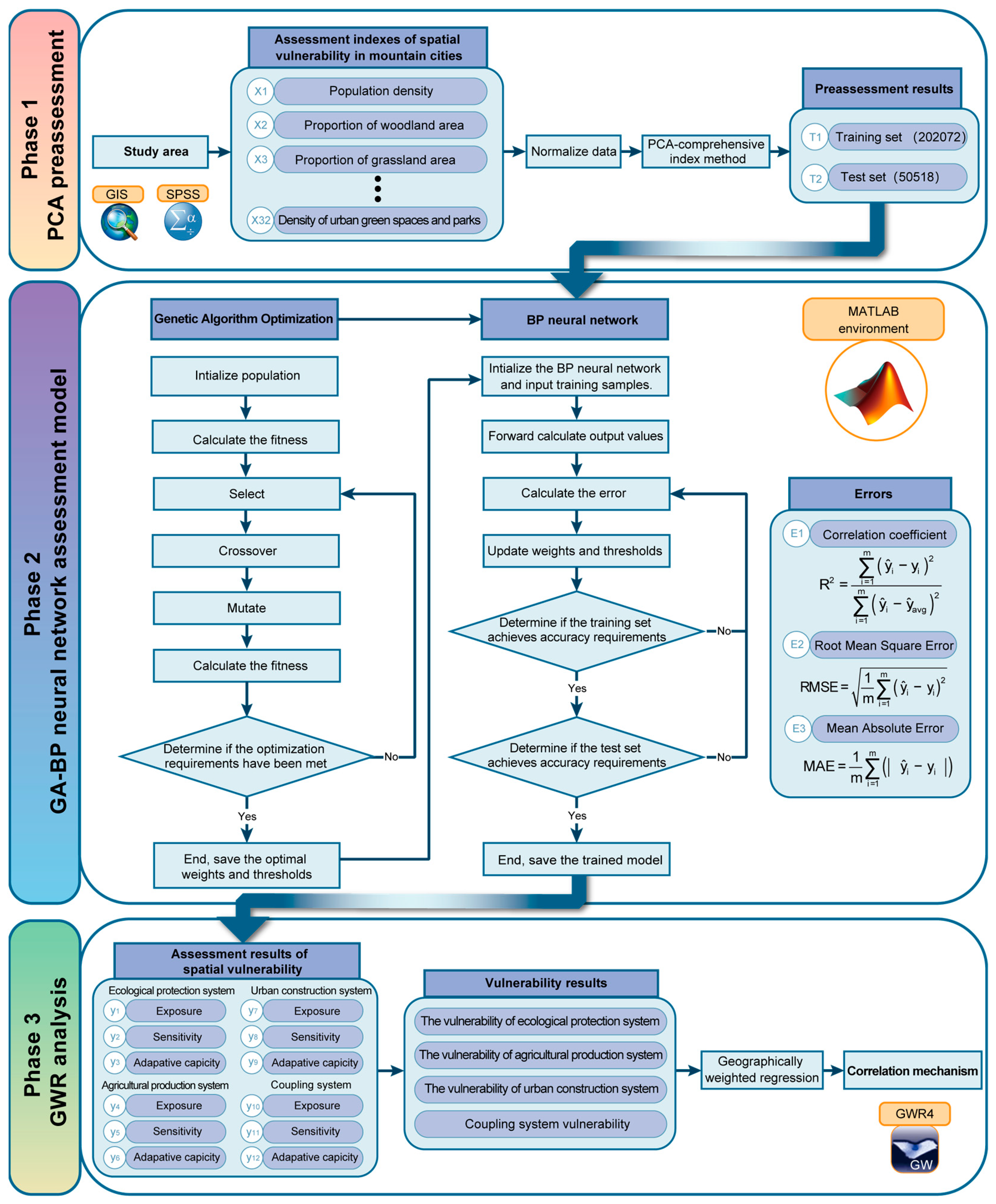

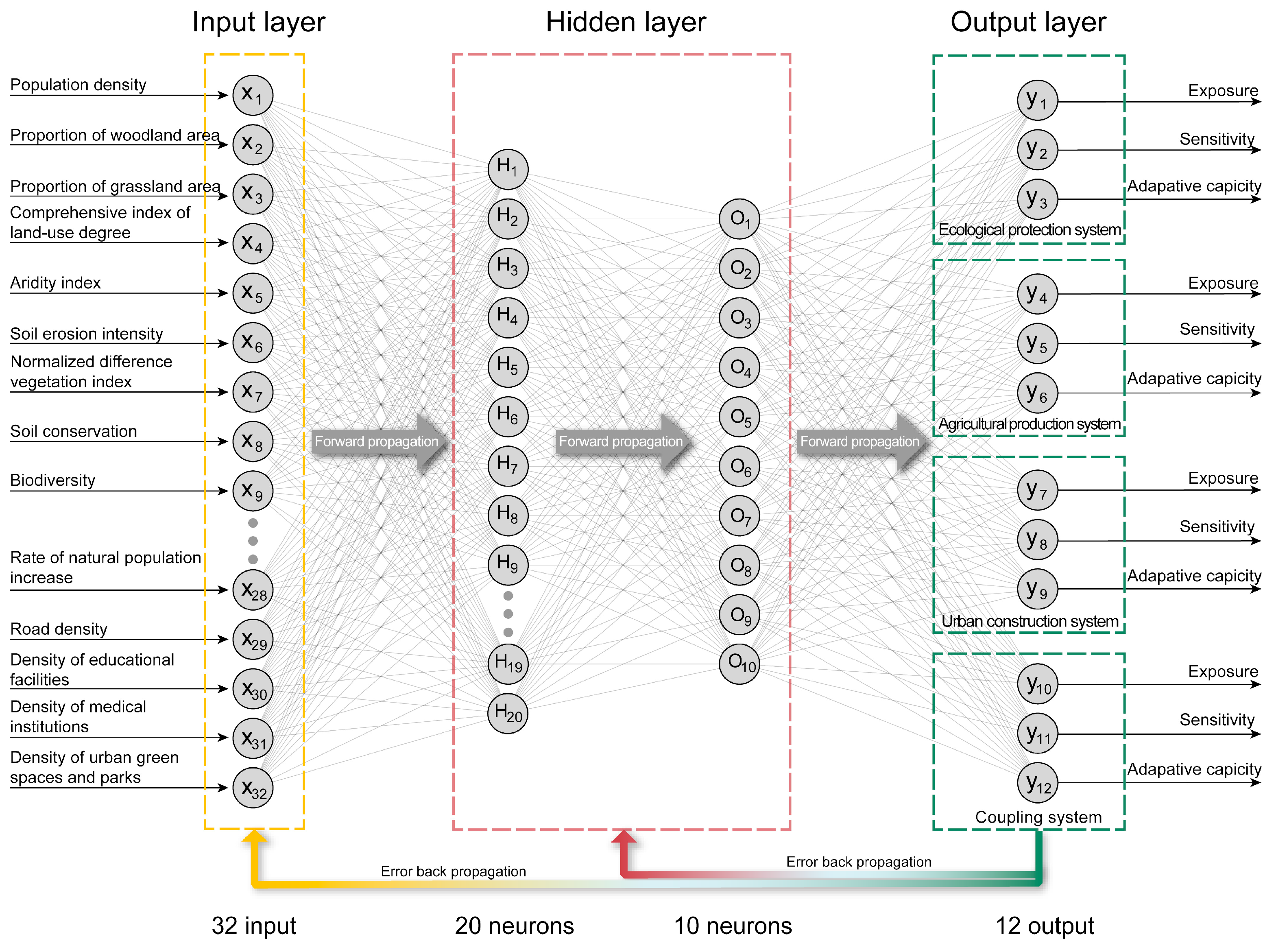

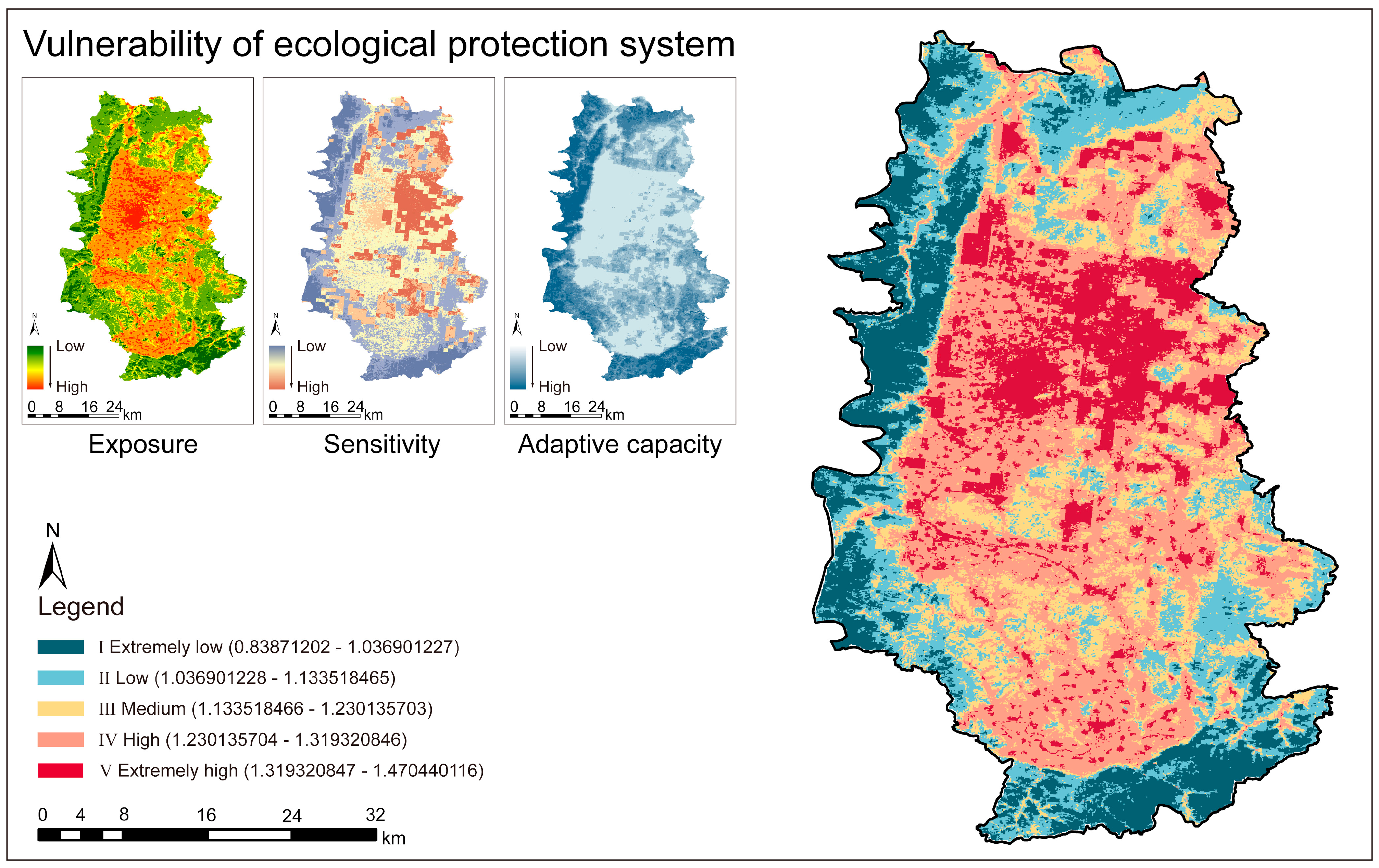
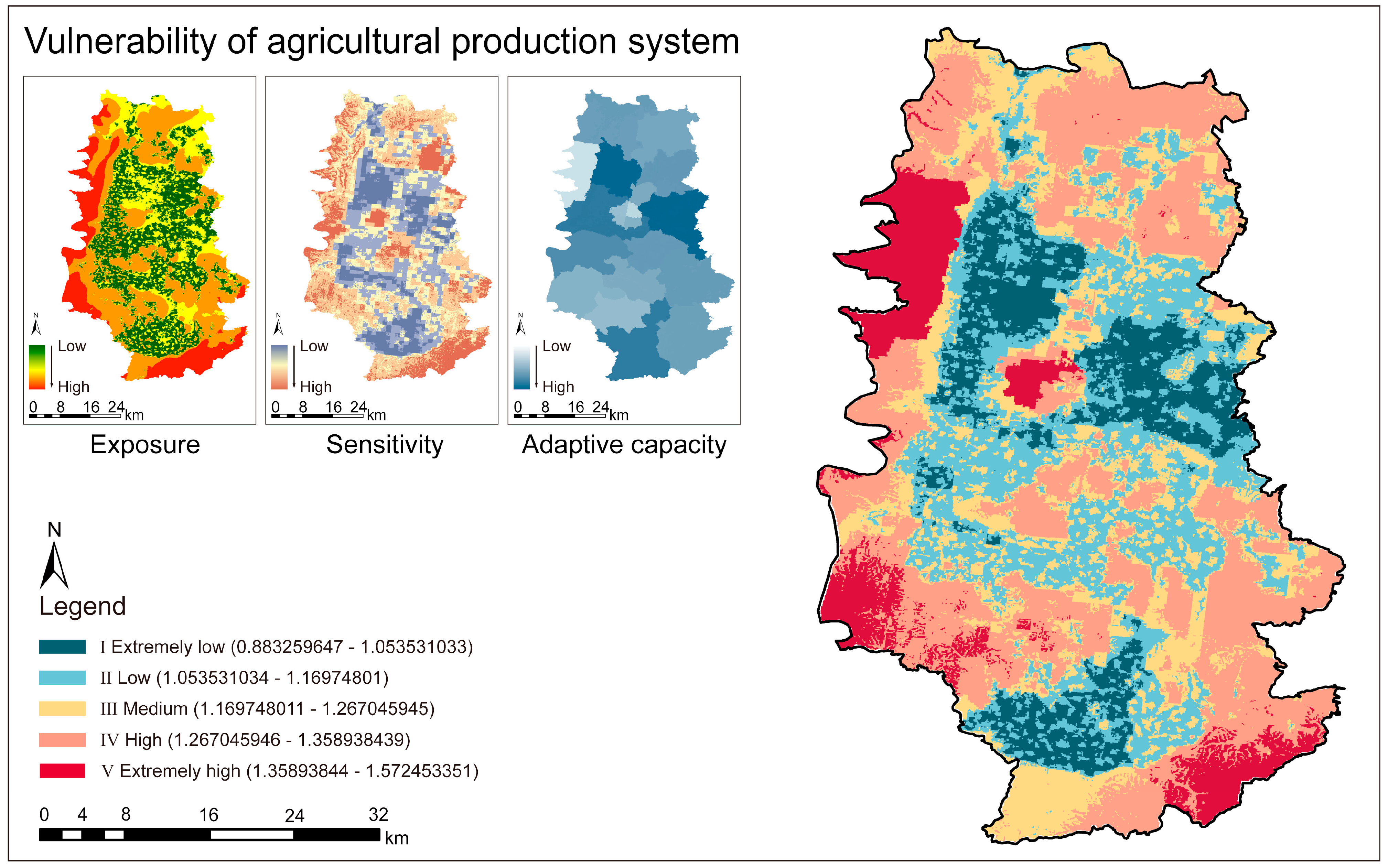
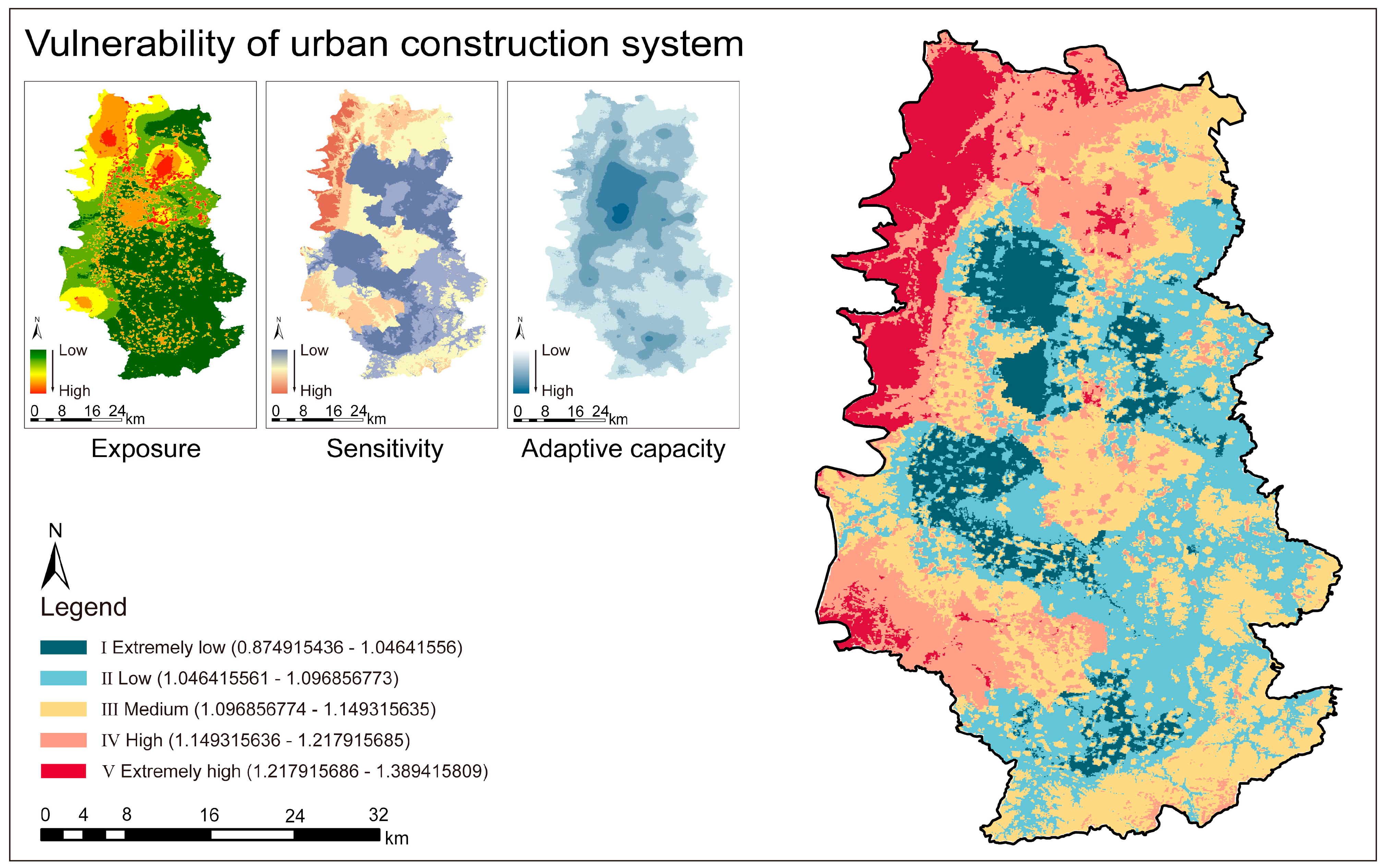
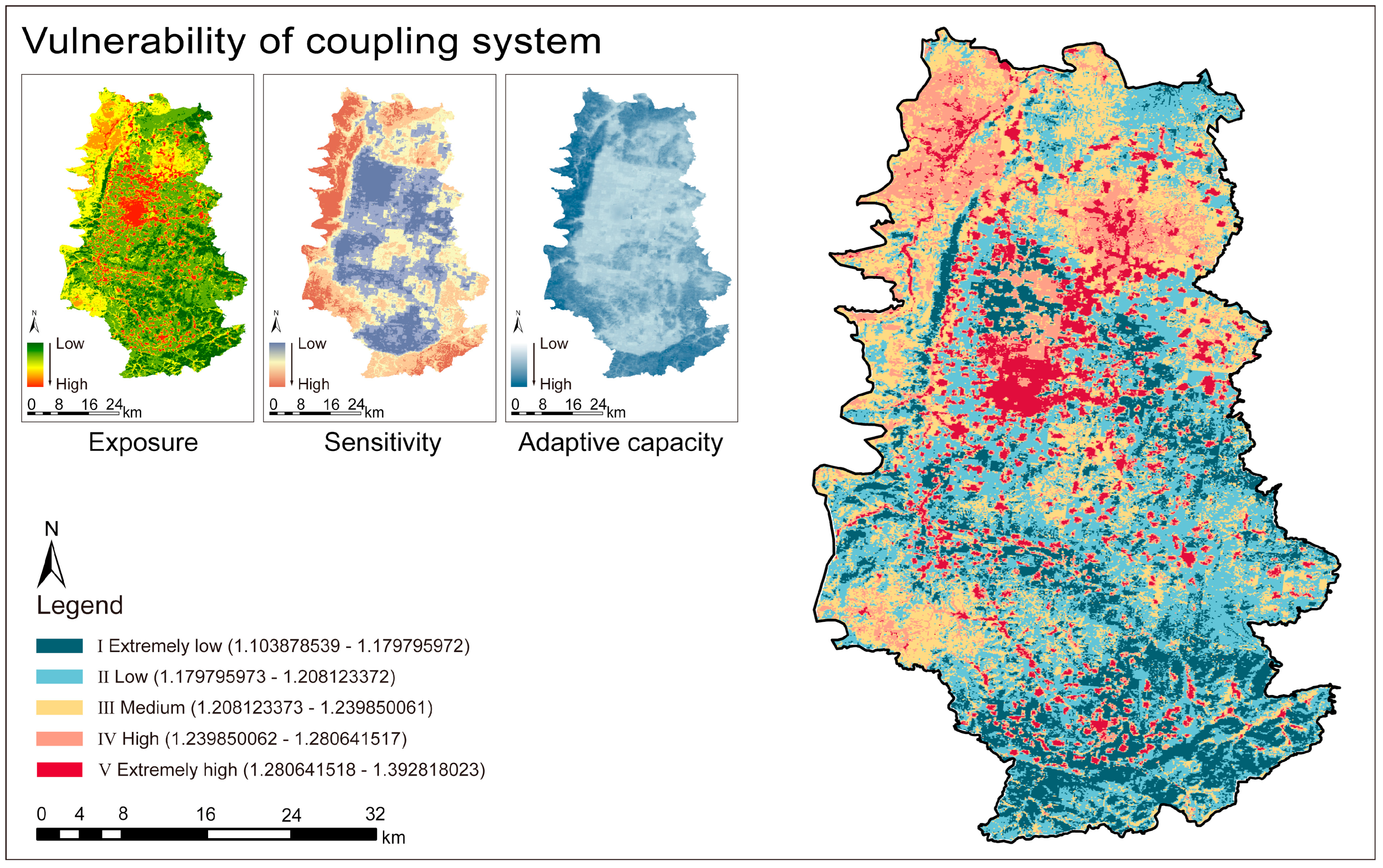
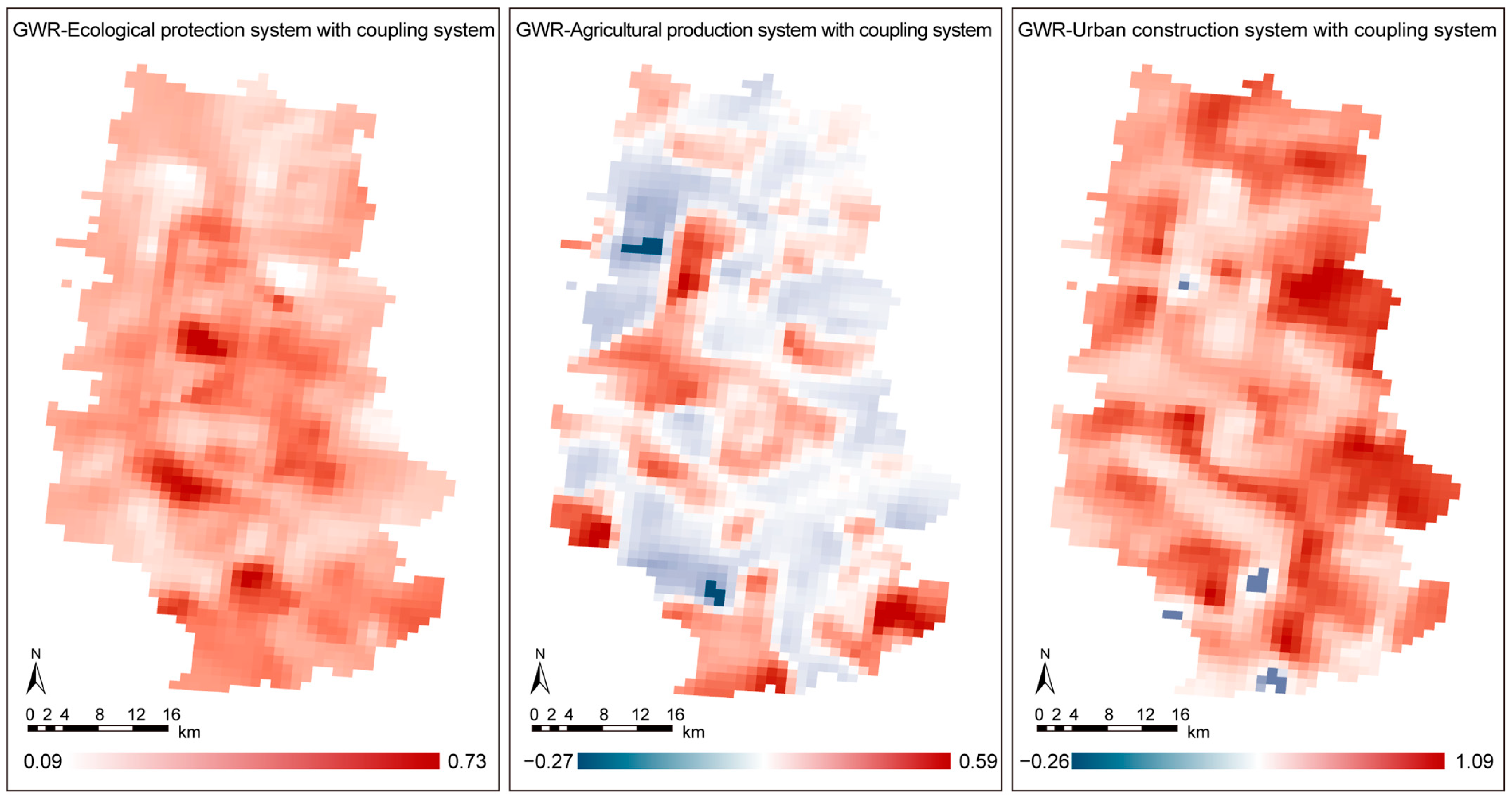
| Coupling System | One-Dimensional Systems | Vulnerability Components | Indicators | Attribute | Unit |
|---|---|---|---|---|---|
| Coupling system | Ecological protection system | Exposure | X1 Population density | + | person/km2 |
| X2 Proportion of woodland area | − | % | |||
| X3 Proportion of grassland area | − | % | |||
| X4 Comprehensive index of land-use degree | + | level | |||
| Sensitivity | X5 Aridity index | − | * | ||
| X6 Soil erosion intensity | + | level | |||
| X7 Normalized difference vegetation index | − | * | |||
| Adaptive capacity | X8 Soil conservation | + | t/(km2·a) | ||
| X9 Biodiversity | + | * | |||
| X10 Water conservation | + | mm | |||
| X11 Climate regulation value | + | 104 Yuan/km2 | |||
| Agricultural production system | Exposure | X12 Intensity of extreme rainfall | + | mm | |
| X13 Proportion of cultivated land | − | % | |||
| Sensitivity | X14 Annual average precipitation | − | mm | ||
| X15 Annual average temperature | − | °C | |||
| X16 Slope | + | ° | |||
| X17 Distance from a water source | + | km | |||
| X18 Farmland productivity potential | − | kg/hm2 | |||
| Adaptive capacity | X19 Number of agricultural workforce | + | person | ||
| X20 Total power of agricultural machinery | + | kw | |||
| Urban construction system | Exposure | X21 Hidden danger of geological collapse | + | pieces/km2 | |
| X22 Hidden danger of landslides | + | pieces/km2 | |||
| X23 Hidden danger of mudflows | + | pieces/km2 | |||
| X24 Nighttime light intensity | + | w/(m2·sr·μm) | |||
| X25 Proportion of construction land | + | % | |||
| Sensitivity | X26 Elevation | + | m | ||
| X27 Topographic undulation | + | m | |||
| X28 Rate of natural population increase | − | % | |||
| Adaptive capacity | X29 Road density | + | km/km2 | ||
| X30 Density of educational facilities | + | pieces/km2 | |||
| X31 Density of medical institutions | + | pieces/km2 | |||
| X32 Density of urban green spaces and parks | + | pieces/km2 |
| One-Dimensional Systems and Coupling System Vulnerability Components | BP Neural Network Errors | GA-BP Neural Network Errors | ||||
|---|---|---|---|---|---|---|
| R2 | RMSE | MAE | R2 | RMSE | MAE | |
| Exposure of ecological protection system | 0.69479 | 0.027822 | 0.022679 | 0.9963 | 0.003061 | 0.002365 |
| Sensitivity of ecological protection system | 0.47229 | 0.032825 | 0.027723 | 0.99927 | 0.001223 | 0.001061 |
| Adaptive capacity of ecological protection system | 0.67779 | 0.0376 | 0.036481 | 0.99731 | 0.003438 | 0.003019 |
| Exposure of agricultural production system | 0. 76123 | 0.032357 | 0.030436 | 0.99963 | 0.001268 | 0.000989 |
| Sensitivity of agricultural production system | 0.64474 | 0.029959 | 0.026154 | 0.99094 | 0.004783 | 0.004195 |
| Adaptive capacity of agricultural production system | 0.63189 | 0.03887 | 0.033521 | 0.99995 | 0.000441 | 0.000375 |
| Exposure of urban construction system | 0.15615 | 0.037361 | 0.037451 | 0.99432 | 0.003065 | 0.002458 |
| Sensitivity of urban construction system | 0.41538 | 0.04246 | 0.039572 | 0.99858 | 0.002092 | 0.001842 |
| Adaptive capacity of urban construction system | −1.7175 | 0.043401 | 0.046305 | 0.98427 | 0.003302 | 0.002881 |
| Exposure of coupling system | 0.36876 | 0.028328 | 0.02677 | 0.98197 | 0.004788 | 0.003628 |
| Sensitivity of coupling system | 0.38124 | 0.034373 | 0.033166 | 0.91547 | 0.012705 | 0.011118 |
| Adaptive capacity of coupling system | 0.5136 | 0.028269 | 0.027746 | 0.99512 | 0.002832 | 0.002366 |
Disclaimer/Publisher’s Note: The statements, opinions and data contained in all publications are solely those of the individual author(s) and contributor(s) and not of MDPI and/or the editor(s). MDPI and/or the editor(s) disclaim responsibility for any injury to people or property resulting from any ideas, methods, instructions or products referred to in the content. |
© 2024 by the authors. Licensee MDPI, Basel, Switzerland. This article is an open access article distributed under the terms and conditions of the Creative Commons Attribution (CC BY) license (https://creativecommons.org/licenses/by/4.0/).
Share and Cite
Duan, Y.; Yu, M.; Sun, W.; Zhang, S.; Li, Y. Spatial Vulnerability Assessment for Mountain Cities Based on the GA-BP Neural Network: A Case Study in Linzhou, Henan, China. Land 2024, 13, 825. https://doi.org/10.3390/land13060825
Duan Y, Yu M, Sun W, Zhang S, Li Y. Spatial Vulnerability Assessment for Mountain Cities Based on the GA-BP Neural Network: A Case Study in Linzhou, Henan, China. Land. 2024; 13(6):825. https://doi.org/10.3390/land13060825
Chicago/Turabian StyleDuan, Yutong, Miao Yu, Weiyang Sun, Shiyang Zhang, and Yunyuan Li. 2024. "Spatial Vulnerability Assessment for Mountain Cities Based on the GA-BP Neural Network: A Case Study in Linzhou, Henan, China" Land 13, no. 6: 825. https://doi.org/10.3390/land13060825






